Pelles Fiskes biggest inventions
Chapter 3 - CDC-12
Text: The Graylinger
Photo: The Graylinger
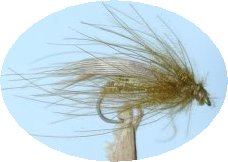 When
CDC entered the fly tying market, we were early adopters to this new
material - the characteristics of the material was really
interesting - now you could tie dry flies that had the ability to
float without being prepareted with some floating spray or oil, and
it really looked nice on the fly with its soft structure. In the
flora of flies we tied using CDC in some or another way, one really
stood out, and still does, the amazing CDC-12!
When
CDC entered the fly tying market, we were early adopters to this new
material - the characteristics of the material was really
interesting - now you could tie dry flies that had the ability to
float without being prepareted with some floating spray or oil, and
it really looked nice on the fly with its soft structure. In the
flora of flies we tied using CDC in some or another way, one really
stood out, and still does, the amazing CDC-12!
As mentioned in the article about the GHE-12,
the classic Européa 12 is classic for a reason - it is a really good
caddis immitation. One of the most significant parts of the e-12 is
the wing; a mallard breast feather tied sedge. That is what makes this
CDC-fly the CDC-12 - the wing is there in classic e-12-style, and that
is also what makes the difference from other CDC-patterns we tried out
and why this pattern will always remain in our fly-boxes. With our
experiance, combined with our willingness to try out new patterns, we
are not afraid to state that the CDC-12 are actually better then the
classic Européa 12, and actually better then all floating caddis
immitation with the exception of the original Ismo-pupa. So, we may
have invented (with the disclaimer that we actually have not tried all
the caddis immitations that are out there - only a lot of the known
ones) the second best, and that is quite a nice feeling.
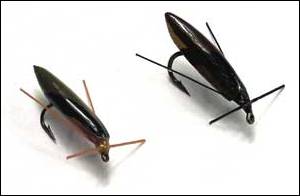 Ok,
our CDC-12 might actually be number two in the rankings of floating
caddis immitation, but how about number one, The Ismo-pupa - what is
that and why is that fly superior?!
Ok,
our CDC-12 might actually be number two in the rankings of floating
caddis immitation, but how about number one, The Ismo-pupa - what is
that and why is that fly superior?!
The Ismo-pupa (Ismopuppa in Swedish) is created by Ismo Hyvärinen from
Kiruna. It is a fly that is quite different from most of our
traditional flies since the body is made of balsa wood, and it takes
quite some time to produce a fly. The balsa wood has to be glued to
the hook, sculptured to get the correct profile, and then the time
comsuming painting job starts. The result is a fly that floats
perfectly and are extraordinary well suited to attract grayling to
stroke.
We have tried several suppliers of the pattern, but none has even been
close to the original - if you can´t get the hold of a Ismo-pupa
created by Ismo himself you can better try something else (especially
since they tend to be quite expensive), and propably with better
result - that is our experiance anyway, and what makes our CDC-12 a
real alternative since an original Ismo-pupa may be hard to find is
you do not happen to be visiting Kiruna :-)
 Leavas,
June 2001.
Leavas,
June 2001.
Our fishing trip had started quite tough - we had caught some fish,
but no more than we bearly could feed upon. The surroundings were
fantastic up there in the most northern part of Sweden and we had the
fishing water all to our self, but what does this help when you can´t
find the fish?
It all changed on day tree when we found the stream we later named
"the mail-stream" (because "it always deliver"). The mail-stream was
formed by four separate small rapids ending up in one common pool, and
just where the rapids ended up in the pool we saw some activity in the
surface. With a CDC-12 on our respective leader we attacked the spot,
and suddenly the fishing was great - the streams and the following
pool seemed to hold nearly an infinite amount of fish and our fishing
trip was suddenly a real success. This was the real test for the
CDC-12, and it proved its abilities. Since then, it has done this over
and over again, and that is the reason we dare to at least state it is
the number two of floating caddis immitations!
We have tried out several coulors and body sizes on the CDC-12, and
the result is that you can be quite flexible on the coulor but not on
the size. Maybe brown CDC is the most allround, but also olive and
blue dun delivers, as long as you keep the hook-size to 12.
Tying the CDC-12
Material
To tie this fly you will need the following materials:
- Hook. Choose a dry fly hook in size 12, for example Mustad 94833
- Thread. We choose a black thread
- Body & hackle. CDC feathers of the wished color - we choose
brown this time
- Wing. As on the regular e-12, a wing of the mallard breast feather
Description
Step 1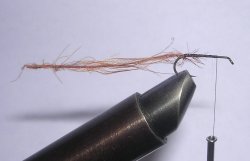 Start by tying up the thread a bit into the hook, and fix a CDC feather in the top where the bend begins on the hook. |
Step 2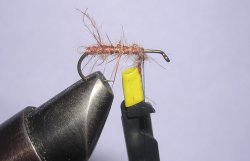 Twist the CDC feather and wrap it up against the hook eye - save a few millimeters for the wing and the hackle. |
Step 3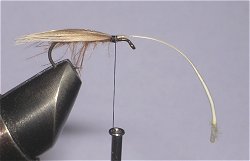 As the wing, tie in a breast feather from mallard, sedge-style. |
Step 4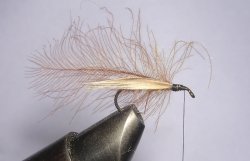 Attach the CDC feather that will form the hackle. |
Step 5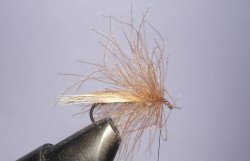 5-6 rounds is enough. |
Step 6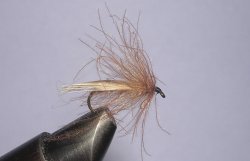 A little head by the thread and then the fly is finished. |
We apologize for the poor English...
/The Graylinger and Raven